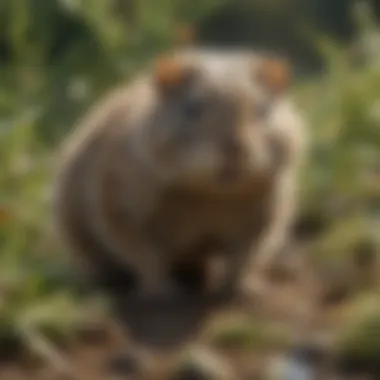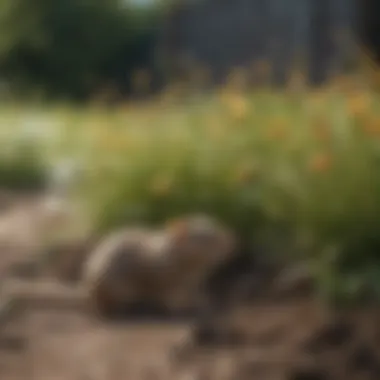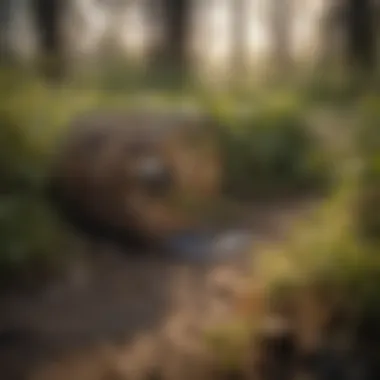Expert Strategies to Safely Eliminate Voles From Your Lawn


Preventive Pest Control Strategies
In this section, we will delve into preventive pest control strategies to help you effectively manage and eliminate voles from your lawn. It is imperative to start your pest control journey by implementing proactive measures to deter voles from wreaking havoc in your garden and landscaping. Let's begin by focusing on safeguarding your house exterior, which serves as the first line of defense against these pesky creatures. Firstly, ensure to seal any cracks or openings that may serve as entry points for voles. Additionally, clearing debris from your yard will remove potential hiding spots for pests, thereby reducing the likelihood of vole infestations. By incorporating these tips for sealing cracks, clearing debris, and preventing pests from entering your home, you can fortify your defenses against vole intrusions.
Understanding Voles
Understanding voles is crucial in the battle to protect your lawn from these destructive pests. Voles, small rodents resembling mice, are known for their tunneling and nesting habits, reproductive patterns, and dietary preferences. By gaining insights into vole behavior and habits, you can effectively strategize ways to eliminate them from your lawn. Understanding their tendencies allows for a targeted approach in vole control, increasing the efficacy of your efforts in safeguarding your garden and landscaping.
Vole Behavior and Habits
Vole behavior encompasses a variety of characteristics that influence their interaction with your lawn. When delving into tunneling and nesting habits, one can appreciate the intricacy of their subterranean homes. Voles construct intricate tunnel systems beneath the surface, providing shelter and protection for themselves and their brood. Their reproductive patterns highlight their prolific nature, with females capable of producing several litters in a single year. This rapid reproduction can lead to exponential population growth if left unchecked. Understanding their dietary preferences is key to implementing effective control measures. Voles primarily feed on vegetation, consuming plant roots and stems. Their herbivorous diet can lead to extensive damage to lawns and gardens if not addressed promptly.
Tunneling and Nesting Habits
Voles exhibit meticulous tunneling and nesting habits, creating interconnected pathways beneath the soil. These tunnels serve as access points to various parts of your lawn, enabling voles to forage for food and evade predators efficiently. While their burrowing behavior aids in vole survival, it poses a significant threat to the integrity of your landscape. By understanding the depth and complexity of these tunnels, you can assess the extent of vole activity on your property and devise suitable control strategies.
Reproductive Patterns
Vole reproductive patterns play a pivotal role in their population dynamics. Female voles showcase remarkable fertility, with the ability to reproduce multiple times throughout the year. This high reproductive rate can lead to rapid vole infestations if conditions are favorable. By recognizing the breeding patterns of voles, homeowners can anticipate population surges and implement proactive measures to curtail vole numbers and mitigate damage to their lawn.
Dietary Preferences
Voles have distinct dietary preferences that influence their foraging behavior. These pests predominantly target plant matter, consuming a wide array of vegetation in their quest for sustenance. Their penchant for gnawing on roots and plant stems can compromise the health and aesthetic appeal of your lawn. By understanding their dietary habits, homeowners can choose vole-resistant plant species and implement repellent strategies to deter voles from feasting on their greenery.
Preventive Measures
Preventive measures play a crucial role in managing vole infestations effectively. By implementing proactive strategies, homeowners can significantly reduce the likelihood of damage caused by these pests. Maintaining a clean lawn is key to deterring voles from residing in the area. Regular mowing not only keeps the grass at an optimal height but also minimizes hiding spots for voles. Removing debris such as fallen leaves and twigs eliminates potential hiding places for voles, making the environment less favorable for them. Additionally, reducing moisture levels in the lawn through proper drainage methods helps create an unfavorable habitat for voles, discouraging their presence.
Maintaining a Clean Lawn
Regular Mowing
Regular mowing is a fundamental aspect of lawn care that promotes overall lawn health and aesthetics. By trimming the grass to a consistent height, typically around 2-3 inches, homeowners can prevent overgrowth that may attract voles. This practice also enhances the appearance of the lawn and promotes thicker grass growth, which can outcompete weeds and prevent soil erosion. While regular mowing requires time and effort, the benefits in terms of lawn health and vole deterrence make it a worthwhile investment for homeowners seeking to maintain a vole-free lawn.
Removing Debris
Removing debris such as fallen branches, leaf piles, and dead vegetation is essential for reducing vole habitat suitability. Voles are drawn to areas with ample cover and nesting material, making debris removal a critical step in vole prevention. Clearing the lawn of debris not only eliminates shelter for voles but also enhances the visual appeal of the landscape. Regular debris removal, especially during the fall season, can significantly reduce vole populations in residential areas.


Reducing Moisture Levels
Effective moisture management is vital in vole control as these pests thrive in damp environments. To reduce moisture levels in the lawn, homeowners should address issues such as poor drainage and overwatering. Proper drainage solutions, including installing French drains or redirecting downspouts, can help prevent water accumulation that attracts voles. Additionally, watering lawns in the morning to allow for evaporation during the day can aid in maintaining optimal moisture levels for grass growth while discouraging vole activity.
Natural Repellents
Castor Oil
Castor oil is a natural vole repellent that disrupts the pests' sense of smell, making the treated area less inviting. By mixing castor oil with water and applying it to the lawn, homeowners can create a barrier that deters voles from foraging. The strong scent of castor oil masks the odors that attract voles, effectively repelling them from the treated area. While castor oil is eco-friendly and safe for the environment, regular reapplication may be necessary to maintain its repellent properties and deter vole activity.
Predator Urine
Predator urine, such as that of foxes or coyotes, acts as a natural deterrent against voles by signaling the presence of a potential predator. By strategically placing predator urine around the perimeter of the lawn or near vole burrows, homeowners can create a sense of danger that encourages voles to seek alternative habitats. While predator urine is a humane vole control method, proper placement and rotation of predator scent are essential to prevent voles from becoming accustomed to the scent and ignoring its warning signals.
Planting Vole-Resistant Plants
Selecting vole-resistant plants for landscaping can help minimize damage caused by voles and reduce the attractiveness of the lawn to these pests. Vole-resistant plants typically have characteristics that make them less appealing to voles, such as strong odors or unpalatable textures. By incorporating vole-resistant plants into the garden design, homeowners can create a natural barrier that deters voles from feeding on their vegetation. While planting vole-resistant plants adds diversity to the landscape and promotes biodiversity, proper selection based on local conditions and preferences is essential for optimal vole deterrence.
Trapping and Removal Methods
In this section, we delve into the crucial aspect of Trapping and Removal Methods in the battle against voles infestation. Trapping is a fundamental strategy in effectively combating vole populations within your lawn. By employing strategic trapping techniques, you can meticulously reduce the vole numbers and prevent further damage to your garden. The correct implementation of removal methods ensures a systematic approach towards achieving a vole-free environment.
Live Trapping
Live trapping is a humane and effective method of controlling vole populations. By capturing voles alive, you can relocate them to a more suitable habitat without causing harm. Understanding the nuances of live trapping is essential for maximizing its efficacy in vole elimination.
Setting Traps
Setting traps is a crucial step in the live trapping process. Careful placement of traps in high activity areas increases the likelihood of capturing voles efficiently. The design of traps plays a vital role in attracting voles, thus improving the overall success rate of trapping efforts. Despite occasional setbacks, setting traps remains a popular choice for its targeted approach and ability to minimize vole populations.
Proper Placement
Proper placement of traps is key to optimizing the effectiveness of live trapping. Strategically positioning traps along vole runways and nesting sites enhances the chances of successful captures. The meticulous placement of traps requires observation of vole behavior and habitat preferences. While challenging at times, proper placement significantly contributes to the success of trapping endeavors.
Release Guidelines
After capturing voles, understanding the proper release guidelines is essential. Releasing voles in suitable environments far from your lawn prevents re-infestation. Following release guidelines ensures the humane treatment of voles and upholds ethical trapping practices. However, adherence to release guidelines may pose challenges in finding appropriate relocation sites.


Using Baits
Incorporating baits into your trapping strategy can enhance trap effectiveness and increase vole capture rates. Understanding the dynamics of bait selection and usage is pivotal in ensuring successful vole elimination.
Effective Baits
Selecting effective baits is critical in enticing voles into traps. The choice of baits that appeal to vole senses increases trap attraction and accelerates the trapping process. Effective baits play a significant role in luring voles towards traps, amplifying trapping efficiency.
Safety Considerations
Prioritizing safety when using baits is imperative to prevent harm to non-target species. Incorporating safety measures in bait placement reduces the risk of unintended consequences. Awareness of potential hazards associated with baits is essential for maintaining a secure trapping environment.
Monitoring Traps
Regular monitoring of traps is essential to assess their efficacy and ensure timely vole removal. Checking traps consistently allows for prompt vole retrieval, preventing prolonged suffering. Continuous trap monitoring aids in gauging vole activity levels and adjusting trapping strategies accordingly.
Professional Assistance
Seeking professional assistance for vole eradication provides a comprehensive solution to persistent infestations. Consulting experts in the field equips you with specialized knowledge and access to advanced vole control methods.
Hiring Exterminators
Engaging exterminators offers a hands-off approach to vole control, with experts handling trapping and removal on your behalf. Professional exterminators possess the expertise to effectively address vole infestations, ensuring thorough elimination. However, the cost associated with hiring exterminators may deter some homeowners.
Consulting Landscaping Companies
Collaborating with landscaping companies proficient in pest control provides tailored vole management solutions. These companies offer customized strategies to suit your lawn's specific needs, incorporating trapping methods effectively. However, the reliance on external services may come with financial implications.
Expert Advice
Accessing expert advice from professionals grants valuable insights into vole behavior and control techniques. Experts can recommend tailored trapping methods and offer guidance on long-term vole prevention. Leveraging expert advice enhances your vole elimination efforts, although implementing expert recommendations may require additional resources.
Natural Predators
In the realm of pest control, enlisting the help of natural predators is a stratagem lesser explored yet remarkably effective. Within this comprehensive guide targeting ways to eliminate voles from your lawn, the role of natural predators assumes a pivotal stance. These predators, such as owls, hawks, snakes, and even domestic pets, play a crucial part in maintaining the ecological balance of your garden ecosystem. They act as a natural deterrent to voles, precluding infestations and minimizing damage.
Encouraging Predator Habitats


Owls and Hawks
Delving into the specific domain of owls and hawks, one uncovers a world sustained by acute predatory skills. Owls and hawks are adept hunters, given their exceptional vision and stealthy approach. Implementing these majestic creatures in your vole eradication strategy can prove to be highly advantageous. Owls, known for their nocturnal prowess, contribute to round-the-clock surveillance of vole activities, ensuring comprehensive coverage and heightened efficacy in vole control. However, challenges such as maintaining owl habitat compatibility and avoiding disruptions in their natural behavior may need attention.
Snakes
Transitioning to the realm of snakes, we encounter a species renowned for its subtle yet formidable presence. Snakes bring a distinct set of advantages to the table in combating vole populations. Their ability to maneuver through intricate environments and access vole habitats that may be otherwise inaccessible to larger predators empowers them as valuable assets in the battle against voles. Snakes bring a unique pest control perspective, relying on ambush hunting tactics and stealth to address vole issues effectively. However, considerations about snake safety and ecosystem balance must be carefully weighed to optimize their utilization.
Domestic Pets
Domestic pets, an integral part of many households, claim their niche as unassuming vole deterrents. With their keen sense of smell and instinctual hunting abilities, pets like cats and dogs contribute significantly to vole population control. Their constant presence in the garden area serves as a continual reminder to voles that they are not free to roam without consequence. While the benefits of domestic pets in vole management are evident, measures to prevent over-predation and maintain pet well-being in harmony with nature's balance are essential aspects to consider. Thus, encouraging predator habitats encompassing owls, hawks, snakes, and domestic pets manifests as a holistic approach to vole elimination, intertwining natural ecosystems with human intervention for sustainable pest control.
Final Thoughts
Continuous Monitoring
Regular Inspections
Regular inspections are the cornerstone of effective vole management. Through routine assessments of the lawn, homeowners can promptly detect any signs of vole activity such as burrows, runways, or new damage to plants. This proactive approach enables timely intervention and adjustment of control strategies to prevent further infestation. Regular inspections provide valuable insights into the effectiveness of implemented preventative and control measures. While demanding, the benefits of regular inspections far outweigh the efforts involved, making it a popular and invaluable practice in vole control.
Adapting Strategies
Adapting strategies involves the dynamic alteration of pest control methods based on monitoring results. This allows homeowners to address vole infestations with tailored approaches, maximizing effectiveness and minimizing resource wastage. Flexibility in strategy adaptation is key to overcoming challenges posed by varying vole behaviors and population dynamics. By having adaptive strategies in place, homeowners can optimize their control efforts and accelerate vole elimination.
Persistence is Key
Persistence in vole control is essential for long-term success. Consistent monitoring, strategic adaptations, and unwavering determination are critical components in sustaining vole-free lawns. While persistent control measures may require time and effort, the rewards of a vole-free garden underscore the importance of perseverance in pest management. Persistence is the linchpin that holds together the various elements of vole elimination strategies, ensuring continued success in maintaining a vole-resistant lawn.
Environmental Considerations
Exploring environmental considerations in vole control sheds light on eco-friendly approaches, responsible pest control practices, and the importance of ecosystem balance preservation. Integrating these aspects into vole management strategies not only minimizes environmental impact but also promotes sustainable lawn care practices.
Eco-Friendly Approaches
Highlighting eco-friendly approaches in vole control underscores the use of natural and non-toxic methods to manage vole populations. Incorporating environmentally safe repellents, traps, and deterrents demonstrates a commitment to sustainable pest control practices. These eco-friendly approaches not only target voles effectively but also safeguard other beneficial organisms in the lawn ecosystem.
Responsible Pest Control
Emphasizing responsible pest control practices underscores the ethical considerations involved in vole management. Opting for humane trapping methods, selecting target-specific baits, and avoiding harmful chemicals align with responsible pest control principles. By prioritizing the well-being of all organisms within the ecosystem, homeowners contribute to a healthier and balanced environment.
Maintaining Ecosystem Balance
Maintaining ecosystem balance is fundamental in vole control as it sustains natural predator-prey relationships and ecological harmony. Encouraging the presence of native predators like owls, hawks, and snakes helps regulate vole populations naturally. Additionally, nurturing a biodiverse lawn with vole-resistant plant species promotes a self-sustaining ecosystem. By focusing on ecosystem balance, homeowners create a resilient environment that naturally deters vole infestations.



